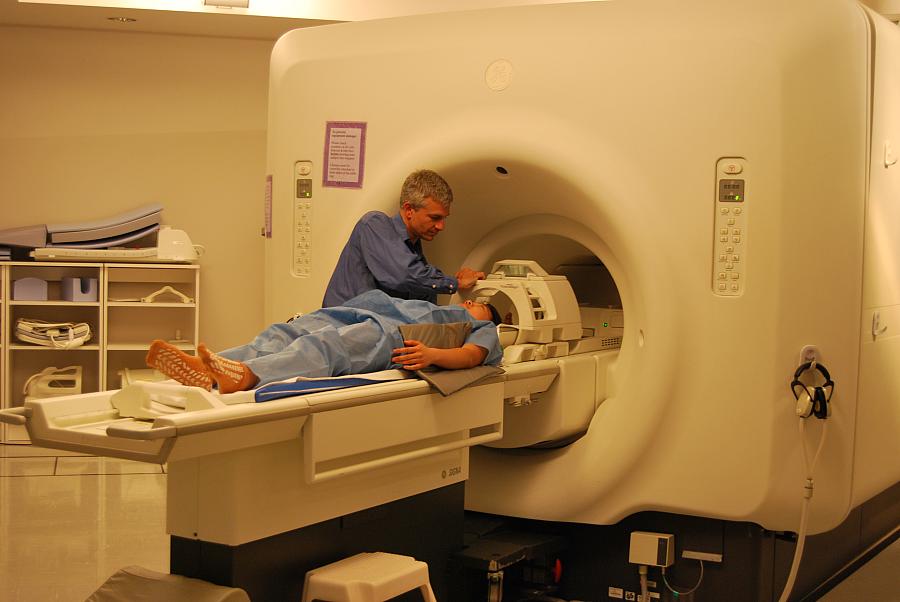Illuminating Depression
I produced an eleven minute TV story on depression, focusing on new research into better understanding the neural mechanisms underlying depression, as well as current treatments, including antidepressants, transcranial magnetic stimulation and cognitive behavioral therapy, a form of talk therapy.

Nearly 15 million Americans suffer from depression. Learn why depression is more than just "feeling blue," the difficulties of treating it with traditional medications and how new tools and research are shedding light on brain structures that may play an integral role in treating it.
Producer's Notes
Depression is hardly new. The Roman physician Galen, in the second century A.D., expounded on the prevailing medical view that four bodily fluids, or humors, existed within all people but that the unique variation of these humors within people resulted in individual differences among people in their behavior and temperament. An excess of black bile, for example, indicated a melancholic personality.
Fortunately, a lot of scientific progress has been made since then in understanding depression to be an organic, brain-based medical condition that afflicts millions. In fact, an individual has a ten to fifteen percent lifetime risk of developing a major depressive episode. But as Dr. Karl Deisseroth, a Stanford neuroscientist and psychiatrist, told me during our interview for “Illuminating Depression”, “Diagnosis is a big challenge because in psychiatry, we don’t have a lab test. There’s not a blood draw that you can do as you might to check how your liver is doing or how your thyroid function is doing.” So given that the diagnosis of depression is based on clinical observation (most often done by a primary care physician), one can’t help feel that hard, empirical understanding of depression is somewhat lacking, especially when compared to diseases of other organs like the heart and lungs where tests do exist to gauge the presence of pulmonary and cardiovascular diseases.
This was the most interesting observation for me when working on this story. Imagine a medical disease that afflicts eighteen million people in the U.S. (26 million if you include Bipolar Disorder), for which more than 160 million prescriptions were filled in 2008, that is one of the leading causes of disability in the U.S., but a disease for which no definitive medical model of pathology exists. Increasingly, doctors are prescribing antidepressants to treat not just depression but a host of other medical conditions, including chronic pain and insomnia, some of which can co-occur with depression. Sure, we’ve made strides since the time of Galen’s bodily humors and the Freudian view of misplaced hostility and mourning to explain depression, but in some respects, we’re still in the dark about why some people get depression while others don’t, why some people respond to one treatment and not another, or why one person will suffer from a form of depression that is less or more severe than another person. This lack of clear, empirical understanding comes at an awful price to victims of depression, as they encounter remarks from people that tell them to “snap out of it”, implying that they somehow can control the emotional crumbling and dark ideations that accompany the disease.
The consequence of all this is that it’s incredibly tough to create effective, lasting treatments for the disease if we can’t exactly track how the disease affects not only specific regions of the brain but the activity among individual brain cells in regions that may not have even been known to play an integral role in the disease. My layperson’s view is that treating depression currently is a bit like bringing in a car to the mechanic and telling him to fix it but there’s a catch – the mechanic can’t get under the hood to observe directly what’s wrong with the car. We suspect that the problem is with the engine but good luck with opening it up and peering into its pistons. So the mechanic attempts to work on the engine but indirectly, and whatever repairs are attempted may affect the engine but they may also have unwanted effects on the car’s transmission, muffler, timing belt, etc.
Fortunately, advances in imaging techniques like two-photon microscopy and fMRI are elucidating the activity of the depressed brain, allowing the previously impenetrable forest of billions of neurons to be explored, to see their pathways altered, their branches pruned by the disease. And scientists like Philippe Goldin and Kelly Werner are compiling biomarkers like DNA and brain blood flow activity to see if those biomarkers can help predict if people suffering from anxiety and/or depression will respond more favorably to cognitive behavioral therapy than to mindfulness meditation, for example. Dr. Deisseroth is using genetically engineered, photosensitive proteins implanted into rodents’ brains to control brain activity at the level of individual neurons.
Dr. M. Bret Schneider told me during our interview, “A real cure for depression is gonna involve being able to selectively affect those portions of the brain which don’t function properly in depression… But fathoming the huge number of possibilities in each brain with every brain being a little bit different than every other one, is gonna require individualized solutions and will be a scientific feat.” I suppose that with a disease as complex as depression, where one’s individual genetic makeup can influence the kinds of side effects one may experience with an antidepressant, it’s apropos that the future of treating and eventually curing it will entail personalized medicine. Until then, let’s hope that more people bring psychiatry into the research lab to study illnesses like depression, for it’s only through the methodical rigor of science that we have the best hope for curing depression.
